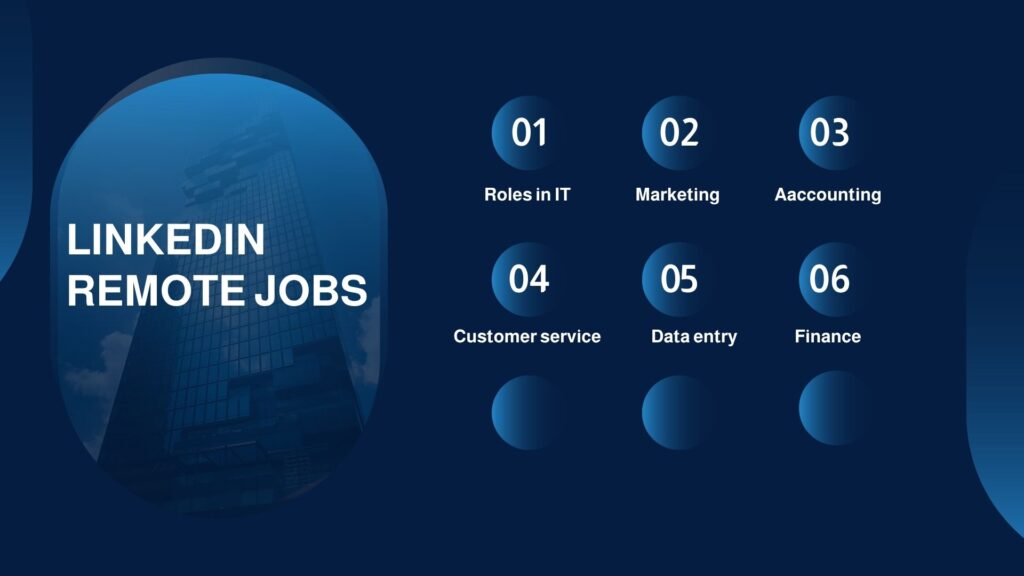I. Understanding the Remote Job Landscape (LinkedIn remote jobs)
A. The Rise of Remote Work
- In today’s rapidly evolving work environment, LinkedIn has become a powerhouse for finding high-paying remote jobs.
- From IT roles to customer service positions, LinkedIn offers a vast array of remote job listings, making it the go-to platform for job seekers aiming to secure flexible, well-compensated opportunities.
- By optimizing your profile, using advanced search filters, and staying up to date with remote job trends, you can unlock the full potential of LinkedIn to land your ideal remote position.

B. Types of Remote Positions Available (LinkedIn Remote Jobs)
- Common remote job roles include IT specialists, digital marketers, and customer service representatives. These positions often allow for flexibility and growth.
- It’s important to understand the differences between freelance work, contracts, and full-time remote roles. Freelancing offers flexibility, while full-time positions typically provide benefits.
- Emerging industries, like e-commerce and health tech, are becoming hotspots for remote job seekers, offering exciting new roles.
C. The Importance of LinkedIn Remote Jobs for Searches
- LinkedIn stands out from other job platforms by allowing users to build professional reputations and engage in industry discussions.
- A strong LinkedIn profile can open doors to remote job opportunities and attract the attention of recruiters looking for remote talent.
- Utilizing LinkedIn’s job search features, such as remote job filters and daily notifications, can streamline your search and connect you with relevant positions.
II. Crafting a Winning LinkedIn Profile (LinkedIn remote jobs)
A. Optimizing Your Profile for Remote Opportunities
- Incorporate relevant keywords related to remote work in your profile summary and job descriptions to improve visibility.
- Highlight skills and experiences that showcase your ability to work independently and manage tasks effectively.
- Customize your LinkedIn headline to reflect your interest in remote work, making it clear to recruiters that you’re seeking remote opportunities.
B. Assembling a Professional Network (LinkedIn Remote Jobs)
- Connect with industry professionals who share similar career goals or have experience in remote work. Personalize connection requests to make a good impression.
- Engage meaningfully by liking, commenting, and sharing posts related to remote work, showing that you’re invested in the community.
- Joining groups focused on remote work can further expand your network and provide insights into the latest trends.

C. Showcasing Achievements and Recommendations
- Gather recommendations from colleagues or clients that highlight your capabilities and reliability as a remote worker. These endorsements can significantly boost your credibility.
- When detailing past work experiences, focus on achievements and use specific metrics to demonstrate your impact.
- Use media and project links in your profile to provide visual proof of your skills, such as presentations or reports.
Check out our Atlassian Careers page for remote job openings and more tips.
III. Finding High-Paying LinkedIn Remote jobs
A. Utilizing LinkedIn’s Job Search Filters
- Use LinkedIn’s job search filters to narrow your search to remote positions. This feature saves time and ensures you’re only looking at relevant opportunities.
- Take advantage of the “Easy Apply” function to submit applications quickly. Additionally, follow companies you’re interested in to stay updated on their openings.
- Save your job searches to receive notifications when new positions that match your criteria are posted.
B. Researching Companies for Remote Compatibility
- Research companies known for their remote capabilities, like flexible work policies and established communication protocols.
- Understanding company culture is crucial. Seeking out companies that offer support for remote teams will increase your chances of job satisfaction.
- Platforms like Glassdoor can provide insight into employee reviews and their experiences in remote work settings.
C. Customizing Job Applications (LinkedIn Remote Jobs)
- Tailor your resume and cover letter for each application. Highlight specific experiences and skills that align closely with the job description.
- Use concrete examples and metrics to demonstrate your past successes and how they relate to the position.
- Following up after submitting an application can show your enthusiasm and dedication to the role.

IV. Mastering Remote Job Interviews (LinkedIn Remote Jobs)
A. Preparing for Virtual Interviews
- Set up a suitable space for your interview: a quiet, well-lit area without distractions. This ensures you can focus fully and present yourself professionally.
- Test your technology in advance to troubleshoot any potential issues with video conferencing tools.
- Prepare answers to common remote job interview questions, such as how you manage your time or handle communication challenges.
B. Communicating Effectively in a Remote Setting
- Maintain professionalism during video calls by dressing appropriately and being mindful of your background.
- Be aware of your body language; it can convey just as much as your words. Maintain eye contact and use gestures to emphasize points.
- Build rapport by actively listening to your interviewer and responding thoughtfully to their questions.
C. Highlighting Remote Work Skills (LinkedIn Remote Jobs)
- Emphasize skills crucial for success in remote jobs, such as self-motivation, communication, and organizational skills.
- Share experiences that illustrate your ability to work independently and show initiative.
- Prepare insightful questions about the company’s remote work culture to demonstrate your genuine interest in the role.
V. Continuous Learning and Adaptability (LinkedIn Remote Jobs)
A. Staying Current with Industry Trends
- Keeping updated in your industry is vital. Consider pursuing ongoing education and certification programs relevant to your field.
- Online platforms like Coursera and edX offer a range of courses that can enhance your skill set.
- Utilize resources like blogs and podcasts within your industry to stay informed about trends and innovations.
B. Leveraging LinkedIn Learning
- LinkedIn Learning provides access to a plethora of courses aimed at skill enhancement. Exploring this feature can greatly increase your employability.
- Focus on courses that are important for your career goals. Completing these courses can also add credibility to your profile.
- Share your completed courses on your profile to showcase your commitment to professional growth.
C. Networking for Knowledge Sharing (LinkedIn Remote Jobs)
- Create or join study groups with others in your field for collaborative learning. These groups can be a great source of insight and motivation.
- Engage in discussions on LinkedIn to share knowledge and learn from others’ experiences.
- Attend virtual events and webinars related to your industry to expand your knowledge and network.

VI. Maintaining Work-Life Balance in Remote Jobs(LinkedIn Remote Jobs)
A. Establishing a Routine
- Creating a consistent work schedule can help mimic the structure of traditional office environments and improve productivity.
- Practice effective time management by prioritizing tasks and setting clear goals for your workday.
- Designate a specific workspace in your home to help separate work and personal life.
B. Setting Boundaries
- Clearly communicate your working hours to family and friends to minimize interruptions.
- Learn to say no to additional tasks or social invitations during work hours to protect your time.
- Implement strategies for digital detox, such as setting aside time away from screens to recharge.
C. Prioritizing Mental Wellbeing
- Recognizing signs of remote work fatigue is crucial. Check in with yourself and adjust your workload if necessary.
- Use strategies such as mindfulness, exercise, and taking regular breaks to maintain mental health.
- Make time for personal interests and activities outside of work to ensure a balanced lifestyle.
VII. Capitalizing on Opportunities for Advancement(LinkedIn Remote jobs)
A. Seeking Mentorship (LinkedIn Remote Jobs)
- Look for mentors within your network who can provide guidance and advice tailored to remote work situations.
- Mentorship can greatly benefit remote professionals, helping you navigate challenges and grow your career.
- When approaching potential mentors, be clear about what you’re hoping to learn and how they can assist you.
B. Taking on Additional Responsibilities
- Be open to growth opportunities by volunteering for projects beyond your usual responsibilities. This can help you gain new skills and visibility.
- Contributing to projects that showcase your talents can strengthen your personal brand within the organization.
- Proactively seek feedback from supervisors to identify areas for improvement and express your commitment.
C. Evaluating Upcoming Job Opportunities (LinkedIn Remote Jobs)
- When reviewing job descriptions, look for roles that encourage professional advancement and skill development.
- Consider factors like growth potential, company values, and culture when deciding whether to apply or move on from current roles.
- Trust your instincts about whether a position aligns with your long-term career goals.

Conclusion (LinkedIn Remote Jobs)
Maximizing your LinkedIn presence can be a game-changer in securing and excelling in remote job opportunities. By understanding the remote job landscape, optimizing your LinkedIn profile, mastering job interviews, and continuously adapting and learning, you can pave the way for high-paying success in the realm of remote work. Embrace the journey, stay adaptable, and prioritize your personal well-being for a fulfilling remote career.
FAQs (LinkedIn Remote Jobs)
What types of jobs can I find on LinkedIn that are remote?You can find a variety of remote jobs on LinkedIn, including roles in IT, marketing, customer service, and more. Additionally, freelance, contract, and full-time positions are available across numerous industries.
How important is my LinkedIn profile for getting remote work?Your LinkedIn profile is crucial for attracting recruiters and employers. A well-optimized profile can increase your visibility and credibility, making you a more attractive candidate for remote positions.
What should I do if I have no remote work experience?If you lack remote work experience, focus on highlighting relevant skills, any freelance work you’ve done, and how your previous experiences can translate to a remote setting. Consider taking online courses to showcase your commitment to learning.
How can I maintain a work-life balance while working remotely?Establishing a routine, setting clear boundaries with work hours, and prioritizing mental wellness strategies are effective ways to maintain a work-life balance while working remotely.
What skills are most in demand for remote jobs?Skills in communication, time management, problem-solving, and self-motivation are highly sought-after for remote positions. Being tech-savvy and proficient with remote collaboration tools is also increasingly important.
